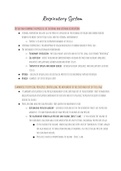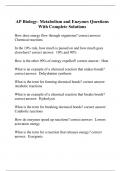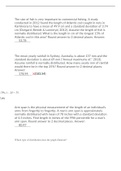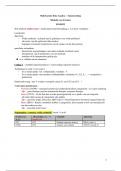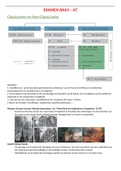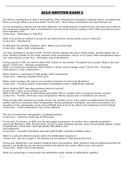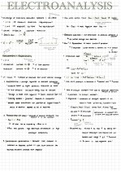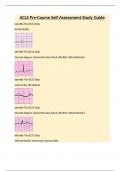Respiratory System
Define and compare the processes of internal and external respiration
● External respiration includes all the processes involved in the exchange of oxygen and carbon dioxide
between the bodies interstitial fluids and the external environment
○ Purpose is to meet the respiratory demands of the cells
● Internal respiration is the absorption of oxygen and release of carbon dioxide by those cells
● The integrated steps in external respiration are:
○ Pulmonary ventilation - physically moves air into and out of the lungs. Also termed “breathing”
○ Gas diffusion - across the blood air barrier between alveolar air spaces and alveolar capillaries,
and across capillary walls between blood and other tissues
○ Transport of oxygen and carbon dioxide - between alveolar capillaries and capillary beds in other
tissues
● Hypoxia - decline of oxygen levels resulting in affected tissues becoming starved for oxygen
● Anoxia - complete cut off of oxygen supply
Summarise the physical principles controlling the movement of air into and out of the lungs
● Pulmonary ventilation is the physical movement of air into and out of the respiratory tract to maintain
adequate alveolar ventilation (movement of air into and out of alveoli) to prevent buildup of carbon
dioxide in alveoli
● There are some basic physical principles that govern the movement of air:
○ Airflow and pressure gradient - air moves into and out of the respiratory tracts due to pressure
gradients. It flows from an area of high pressure to an area of low pressure
○ The relationship between gas pressure and volume (boyle’s law) - if you decrease the volume of
the container, collisions will occur more often per unit of time, increasing the pressure of gas
■ If you increase the volume, fewer collisions occur per unit of time because it takes longer
for a gas molecule to travel from one wall to another, as a result the gas pressure inside
the container decrease
■ Pressure is inversely proportional to volume - Boyle's law
, Each lung is surrounded by a pleural cavity. The parietal and visceral pleura are separated by a thin film of pleural
fluid which allows the two membranes to slide across one another but still be held in place. Hence why the surface of
each lung sticks to the inner wall of the chest and the superior surface of the diaphragm. Movements of the
diaphragm or rib cage that changes the volume of the thoracic cavity and the volume of the lungs.
● The diaphragm forms the floor of the thoracic cavity and it projects superiorly into the thoracic cavity
● When the diaphragm contracts it moves inferiorly which increases the volume of the thoracic cavity and
decreasing the pressure
● When it relaxes it returns to its original position and the volume of the thoracic cavity decreases
● Raising the rib cage involves both superior and anterior movements which increase the depth and width of
the thoracic cavity and increase its volume
● Return of the rib cage to its original position decreases the volume of the thoracic cavity
● Air continues to enter the lungs until their volume stops increasing and the internal pressure is the same
as the external pressure
describe the actions of respiratory muscles
● Primary respiratory muscles (diaphragm and external intercostals) are active during normal breathing
and rest
● Accessory respiratory muscles become active when the depth and frequency of breathing needs to be
increased
● Inhalation is an active process and involves the following muscles and actions:
○ Contraction of the diaphragm flattens to the floor of the thoracic cavity and increases its
volume drawing air into the lungs
○ Contraction of the external intercostal muscles assists in inhalation by raising the ribs
○ Contraction of accessory muscles including the sternocleidomastoid, scalene, pectoralis minor
and serratus anterior assists the external intercostal muscles in elevating the ribs
● Exhalation is passive or active depending on
the level of respiratory activity and involves
the following muscles and actions:
○ The internal intercostal muscles
and transversus thoracis depresses
Define and compare the processes of internal and external respiration
● External respiration includes all the processes involved in the exchange of oxygen and carbon dioxide
between the bodies interstitial fluids and the external environment
○ Purpose is to meet the respiratory demands of the cells
● Internal respiration is the absorption of oxygen and release of carbon dioxide by those cells
● The integrated steps in external respiration are:
○ Pulmonary ventilation - physically moves air into and out of the lungs. Also termed “breathing”
○ Gas diffusion - across the blood air barrier between alveolar air spaces and alveolar capillaries,
and across capillary walls between blood and other tissues
○ Transport of oxygen and carbon dioxide - between alveolar capillaries and capillary beds in other
tissues
● Hypoxia - decline of oxygen levels resulting in affected tissues becoming starved for oxygen
● Anoxia - complete cut off of oxygen supply
Summarise the physical principles controlling the movement of air into and out of the lungs
● Pulmonary ventilation is the physical movement of air into and out of the respiratory tract to maintain
adequate alveolar ventilation (movement of air into and out of alveoli) to prevent buildup of carbon
dioxide in alveoli
● There are some basic physical principles that govern the movement of air:
○ Airflow and pressure gradient - air moves into and out of the respiratory tracts due to pressure
gradients. It flows from an area of high pressure to an area of low pressure
○ The relationship between gas pressure and volume (boyle’s law) - if you decrease the volume of
the container, collisions will occur more often per unit of time, increasing the pressure of gas
■ If you increase the volume, fewer collisions occur per unit of time because it takes longer
for a gas molecule to travel from one wall to another, as a result the gas pressure inside
the container decrease
■ Pressure is inversely proportional to volume - Boyle's law
, Each lung is surrounded by a pleural cavity. The parietal and visceral pleura are separated by a thin film of pleural
fluid which allows the two membranes to slide across one another but still be held in place. Hence why the surface of
each lung sticks to the inner wall of the chest and the superior surface of the diaphragm. Movements of the
diaphragm or rib cage that changes the volume of the thoracic cavity and the volume of the lungs.
● The diaphragm forms the floor of the thoracic cavity and it projects superiorly into the thoracic cavity
● When the diaphragm contracts it moves inferiorly which increases the volume of the thoracic cavity and
decreasing the pressure
● When it relaxes it returns to its original position and the volume of the thoracic cavity decreases
● Raising the rib cage involves both superior and anterior movements which increase the depth and width of
the thoracic cavity and increase its volume
● Return of the rib cage to its original position decreases the volume of the thoracic cavity
● Air continues to enter the lungs until their volume stops increasing and the internal pressure is the same
as the external pressure
describe the actions of respiratory muscles
● Primary respiratory muscles (diaphragm and external intercostals) are active during normal breathing
and rest
● Accessory respiratory muscles become active when the depth and frequency of breathing needs to be
increased
● Inhalation is an active process and involves the following muscles and actions:
○ Contraction of the diaphragm flattens to the floor of the thoracic cavity and increases its
volume drawing air into the lungs
○ Contraction of the external intercostal muscles assists in inhalation by raising the ribs
○ Contraction of accessory muscles including the sternocleidomastoid, scalene, pectoralis minor
and serratus anterior assists the external intercostal muscles in elevating the ribs
● Exhalation is passive or active depending on
the level of respiratory activity and involves
the following muscles and actions:
○ The internal intercostal muscles
and transversus thoracis depresses


